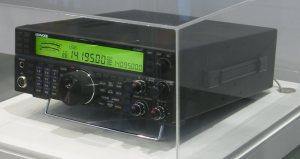Yaesu introduces its new high performance HF-transceiver at the last Dayton Hamvention. It is, again, a wonderful piece of equipment. I have been using Yaesu’s FT-450 entry level rig for many years now, with much pleasure. It packs a lot of functionality and performance in a small and convenient package and I just love it.
So how about the new FTdx1200?
The exterior of the new 1200 looks very much like last year’s FTdx3000. In fact, I had a hard time finding the differences. The color-LCD of the FTdx1200 is a bit larger (4.3in against the 3.5in of the 3000) and the 3000 has a secondary display above the large tuning dial showing the currently selected frequency.
Comparing the specifications of the FTdx3000 vs. FTdx1200 shows the two rigs are also very similar on the inside also. Both cover all the ham bands between 160 and 6 meters and both feature general coverage receiver range (30 kHz ~ 56 MHz). Sensitivity and selectivity is almost identical, with a small advantage for the newer FTdx1200. The FTdx1200 also features a more advanced receiver, with an extra IF-stage at 24 kHz (!) for AM and FM reception. Both rigs come with a 32-bit DSP processor, allowing you to tune IF-width and -shift to find those tiny signals amidst the noise and pileups.
That leaves only the prices to be compared. Currently, the FTdx3000 is listed for USD 2600 and the FTdx1200 goes for as little as USD 1900. I somehow get the feeling Yaesu has just out-priced its own stock. If you can live without the secondary display, the new FTdx1200 seems like a very sensible choice.
73!
Note: as PD0AC points out, you may need to purchase the USD 220.- optional USB interface unit to be able to update the firmware. Seems odd to me, if this is in fact true.









